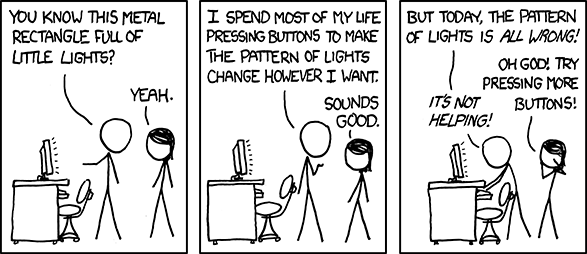· 9 min read
Top 5 Lessons from the Helpdesk
Some observations from the "beginning" of my career, working on the help desk.

It’s a bit of a cliché, but after spending more than a decade at one company, I thought that it might be worth documenting the start of my tech journey what I’ve learned along the way. I hope it’s helpful for someone starting out in their tech career. (If that’s you, feel free to contact me!)
First, a little of my background…
My Tech Background
I “officially” started my tech career 11 years ago, but I don’t have a tech degree. I hadn’t studied software engineering in university. My tech education came solely from hands on experience. I was very fortunate that my dad let me play around with the family computer when I was a kid.
I broke that computer more often than not. I’d try something, mistype a command, and everything would go horribly wrong. I’d frantically try to fix it before my dad found out. Most of the time I was successful. Sometimes there was an awkward conversation when we had to figure it out together.
I say this becausls e I’ve found that learning is usually not straightforward. You try something, you fail, and you try something else. You won’t have it all figured out, you figure it out as you go along. And so, if you’re new to tech— expect a few scrapes along the way as you learn.
A Helpdesk Job
When I applied for a tech support role, I just needed a job. I was in my twenties with a wife and a brand new baby. We were living in a small apartment that we could barely afford. I didn’t know much about life, and I didn’t much have direction. I just needed to do something to provide for my family.
I was hired for the internal-facing helpdesk— which meant I helped people who already worked for Quicken Loans. I now had a job so I could put food on the table. This is where it all began.
 Credit: https://xkcd.com/722
Credit: https://xkcd.com/722
Lesson 1: Good leaders care about people.
In the early years of my tech career, I received much more than a paycheck. Yes, I learned tech skills, but more than that I was fortunate to have leaders who really cared about me. (Props to Vincent Stuckey, Jon Fouts and Janice Love-Ceesay!) My leaders invested in me at a critical time in my life. They taught me that I was more than just another cog in the support machine. I was more than the number of tickets I could complete in a day.
I remember multiple times when a leader was tuned in to what was going on in my personal life. It would be a Monday morning, and someone would take the time to ask a question about my weekend and really listen. Or, during the week they’d ask about what it was like to have a new baby. They’d ask about significant events happening in my personal life. Janice especially was great at this— she checked in regularly to make sure that me and my new family we were doing well. I could tell that she wasn’t just checking a box, she actually cared about me. That support made a huge difference to me as a new father trying to figure things out.
Janice taught me that good leaders care about people. Yes, it’s a leader’s job to meet company goals… but the best leaders find a way to balance the needs of the company and the needs of the individuals at the same time. A great leader cares about the whole person, and not just what that person can do for the company. Leadership is about building those relationships. I’m reminded of this quote:
“People don’t care how much you know, until they know how much you care.”
Good leaders care about people.
Lesson 2: Have a plan. Follow the plan.
Most days on the help desk were routine. Take the calls and tickets, be professional, and work through each request until the queue was empty. But when one of our major systems went down, it was anything but routine. In fact, it was rough. The call queue would stack up into the triple digits, and it seemed like everyone who called in was angry. None of us on the helpdesk had the skills, access, or ability to bring the crucial system back online. We were often waiting, just like everyone else.
In spite of the chaos, what each of us could do was follow the emergency plan. We had prepared for this and we knew what to do when the phone lines were on fire. We knew how to activate the incident process and communicate with the right folks. We collected the information the engineers needed to solve the problem. We had all hands on deck, and we knew what to do.
I was thankful that we had a plan. Following the plan made a very stressful day a little less stressful. Whether the outage was just a few minutes or multiple hours long— ultimately the time flew by because the well-worn routine kicked in. It was muscle memory. We didn’t have to re-think things in a high-stress situation. We had a plan and we followed the plan.
Lesson 3: Seek to understand.
Sometimes a support call can be downright awful. It was rare, but a team member might call in livid because they lost an important file, or because they were not able to work at all. Or maybe they were calling in again because someone on the support side had dropped the ball, and now they were demanding answers. Although I had nothing to do with creating the initial problem, I became the object of their anger and frustration.
At first, it was hard not to take this personally. It’s natural to be defensive. I didn’t deserve to be treated this way! I soon learned that my defensiveness was counter-productive to solving the problem.
What was actually helpful during those difficult calls was to lean in and try to understand the team member more. Why they were angry? How were they not being properly understood? What question could I ask to gain more understanding? What detail did another technician miss that could be the key to resolving the customer’s issue?
Seeking to understand the situation and the caller was the path to resolving the problem. More understanding led to much better solutions. Seek to understand instead of reacting out of anger.
Lesson 4: Ask for help.
With some more experience and a shiny new “senior” title, I gained confidence. It felt good when I could help someone with their issue quickly and amaze them at the same time.
Having the new title felt good, but I soon learned that being a “senior” or an “expert” wasn’t the final destination, but a signpost along the journey. It just meant that I was more aware of what I didn’t already know.
There were times where I couldn’t help a team member quickly, or sometimes, at all. Sometimes I didn’t have the skill or knowledge and that felt very frustrating… after all, I was a senior tech. I so badly wanted to do it myself (even if I would struggle) instead of asking for help.
Over time, I learned where my limitations were. I learned that my pride was not helpful. I needed to have a humble attitude and an open mind— it was only then that I could truly grow. I recognized that others may be better equipped to solve an issue than I am, and that’s a good thing. It was better to understand my limitations and get help than to struggle alone (and take a customer along for the ride). There’s nothing shameful about recognizing that you need help.
When you’re new, it can be hard. Learning might be slow and difficult for you, and you want to prove that you’re capable. Don’t be afraid to ask for help. On the flip side, if you’re more experienced, work on keeping an open mind. Don’t be too proud to ask for help.
At the end of the day, we all still have much more to learn. Find others who are more capable and learn from them. It’s good to ask for help.
Lesson 5: Understand your audience.
One thing about working on the helpdesk is that you never know who you’ll talk to next. Would the next call be from a mortgage banker or a director? Every call was a new challenge.
The system that funneled calls gave us the basic stats of the person calling in. It showed the name, title, and badge photo of the person. Sometimes that was helpful, because if I was speaking with a “software engineer”, I could usually assume they had a tech background.
However, I couldn’t rely on a person’s title alone. Every team member who called in was unique and I needed to listen carefully. I could be speaking with a person who had a non-technical title but they had deep technical knowledge. On the other hand, I could be speaking with someone else who had “engineer” in their title but they struggled to navigate their machine.
I soon learned how critical it was to understand my audience and adjust communication accordingly. If a person was working from home and had an issue with their “modem”, I needed to figure out what they meant. Did they mean their actual modem, their desktop computer, their monitor, or something else? Using a term like “modem” had an entirely different definition for a tech person vs. a non-tech person. Asking questions to build a shared level of understanding was key.
On the other hand, if I assumed zero tech knowledge for everyone, that was an issue as well. A technical person didn’t need to build understanding from scratch, and could become frustrated if I tried to do that. I needed to use shared terminology and speak at the appropriate level. Properly calibrating to my audience meant we could fly through troubleshooting steps more efficiently.
Summary
- Lesson 1: Good leaders care about people.
- Lesson 2: Have a plan. Follow the plan.
- Lesson 3: Seek to understand.
- Lesson 4: Ask for help.
- Lesson 5: Understand your audience.